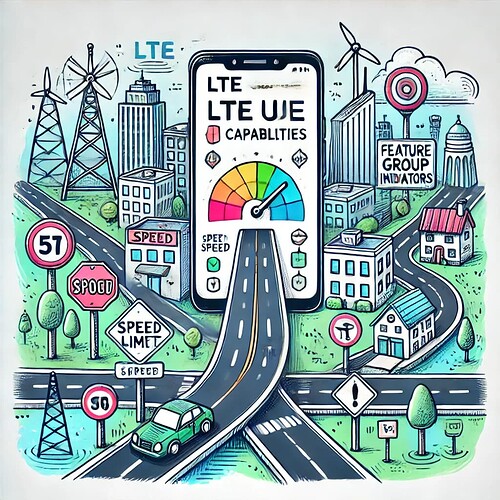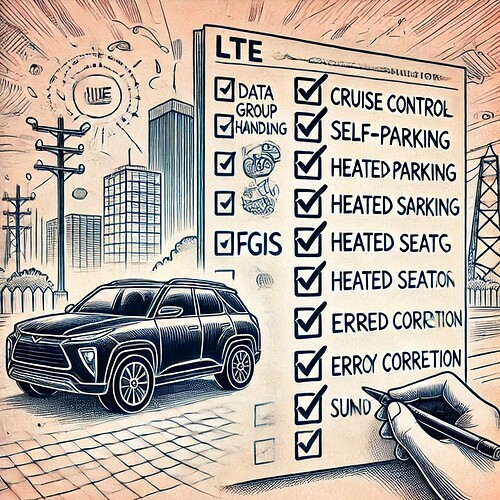This topic presents in a very simplified way all the main concepts that should be understood by those who know LTE.
LTE UE Capabilities
LTE UE Capabilities refer to the different technical features and performance levels that a device (UE) supports when communicating with a network. These include UE Categories, which define the device’s speed and data handling capacity, like how fast and how much data it can send and receive. Other capabilities include support for features like Carrier Aggregation, MIMO (multiple antennas), and operating on various frequency bands, allowing the device to optimize performance under different conditions. Feature Group Indicators provide a detailed list of these supported features, helping the network manage and allocate resources effectively for that specific device. Together, these capabilities ensure efficient communication and maximum performance for the device within the LTE network.
![]() In LTE, UE Capabilities are like describing what your phone (the device) can do when it “drives” on the city’s roads (the network). The UE Categories are like the speed limits your phone can handle - some phones can drive really fast, while others move slower. Other capabilities are like saying which roads your phone can drive on, whether it can take shortcuts (using multiple antennas or different frequency bands) or only stick to the main roads. The Feature Group Indicators are like a checklist for the city to see what special driving skills your phone has, making sure it gives your phone the right path to take for the best journey possible!
In LTE, UE Capabilities are like describing what your phone (the device) can do when it “drives” on the city’s roads (the network). The UE Categories are like the speed limits your phone can handle - some phones can drive really fast, while others move slower. Other capabilities are like saying which roads your phone can drive on, whether it can take shortcuts (using multiple antennas or different frequency bands) or only stick to the main roads. The Feature Group Indicators are like a checklist for the city to see what special driving skills your phone has, making sure it gives your phone the right path to take for the best journey possible!
Skip to: Roadmap to LTE
UE Categories
UE (User Equipment) Categories define the performance level of a device in LTE. Think of it like the “grade” or “level” of your phone. Higher categories mean your phone can handle faster data speeds and process more data at once. This is important for the network to know, so it can send the right amount of data without overwhelming the device. UE Categories classify devices based on their capabilities, like how fast they can download or upload data. Each category, from 1 to 20, indicates what the device can handle, with higher numbers supporting faster and more complex data transfers.
![]() Imagine your phone as a car in the city. UE Categories are like the size and speed of your car. Some cars can drive really fast and carry more people or packages (data), while others are slower and carry less. The network (city) needs to know what kind of car your phone is so it can direct the right amount of traffic (data) without causing a jam or slowing things down. It’s like rating cars based on their speed and efficiency. These categories help the city (network) understand what each car (device) is capable of.
Imagine your phone as a car in the city. UE Categories are like the size and speed of your car. Some cars can drive really fast and carry more people or packages (data), while others are slower and carry less. The network (city) needs to know what kind of car your phone is so it can direct the right amount of traffic (data) without causing a jam or slowing things down. It’s like rating cars based on their speed and efficiency. These categories help the city (network) understand what each car (device) is capable of.
- Search Forum
 LTE UE Categories
LTE UE Categories 
Other Capabilities
Other Capabilities are additional features or functions that your device might support, apart from speed, enhance their performance. This can include things like whether your phone can handle Carrier Aggregation (combining multiple carriers for faster data speeds), ability to connect to multiple network bands, advanced features like MIMO (multiple antennas for better signal), improved battery efficiency, and advanced data processing features. These capabilities help the network understand the full potential of the device and use it to deliver the best performance.
![]() Now, think of your car having extra features like GPS, a sunroof, better fuel economy, advanced safety systems, or a bigger engine. Other capabilities are like these extra features on your phone that make it work better. It could handle more roads at once (Carrier Aggregation), drive on different types of streets (frequency bands), or have multiple engines (MIMO antennas) for smoother driving. These extra features help your phone navigate the network more efficiently - devices can connect to multiple network bands, save battery better, and process data faster. These added features make devices perform better in our city.
Now, think of your car having extra features like GPS, a sunroof, better fuel economy, advanced safety systems, or a bigger engine. Other capabilities are like these extra features on your phone that make it work better. It could handle more roads at once (Carrier Aggregation), drive on different types of streets (frequency bands), or have multiple engines (MIMO antennas) for smoother driving. These extra features help your phone navigate the network more efficiently - devices can connect to multiple network bands, save battery better, and process data faster. These added features make devices perform better in our city.
- Search Forum
 LTE UE Other Capabilities
LTE UE Other Capabilities 
Feature Group Indicators
Feature Group Indicators (FGIs) is like a checklist of special features that the device supports. It tells the network what extra capabilities the device has, such as support for certain types of data transmission or advanced error-correction techniques. The more features a device supports, the more efficiently it can communicate with the network. This helps the network understand what the device can do and provide the best possible service.
![]() Feature Group Indicators are like a checklist of all the cool features your car has. Does it have cruise control? Can it park itself? Does it have heated seats or a sunroof? In the same way, your phone tells the network all the special features it supports, like handling bigger data loads or managing errors better. This helps the network give your phone the best routes and conditions to keep everything running smoothly, letting the network know exactly what each device can do to ensure the best possible service that matches the device’s capabilities.
Feature Group Indicators are like a checklist of all the cool features your car has. Does it have cruise control? Can it park itself? Does it have heated seats or a sunroof? In the same way, your phone tells the network all the special features it supports, like handling bigger data loads or managing errors better. This helps the network give your phone the best routes and conditions to keep everything running smoothly, letting the network know exactly what each device can do to ensure the best possible service that matches the device’s capabilities.
- Search Forum
 LTE Feature Group Indicators (FGIs)
LTE Feature Group Indicators (FGIs) 
That’s it. ![]()
-
Continue reading: Roadmap to LTE - Bit Rates
-
Or back to: Roadmap to LTE



